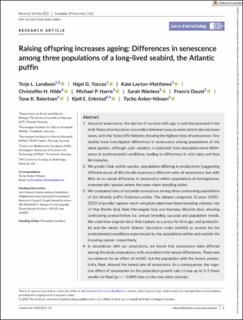| dc.contributor.author | Landsem, Terje Lorentzen | |
| dc.contributor.author | Yoccoz, Nigel Gilles | |
| dc.contributor.author | Layton-Matthews, Kate | |
| dc.contributor.author | Hilde, Christoffer Høyvik | |
| dc.contributor.author | Harris, Michael P | |
| dc.contributor.author | Wanless, Sarah | |
| dc.contributor.author | Daunt, Francis | |
| dc.contributor.author | Reiertsen, Tone Kristin | |
| dc.contributor.author | Erikstad, Kjell E. | |
| dc.contributor.author | Anker-Nilssen, Tycho | |
| dc.coverage.spatial | Isle of May, North Sea, Røst, Norwegian Sea, HOrnøya, Barents Sea | en_US |
| dc.date.accessioned | 2023-02-28T08:13:16Z | |
| dc.date.available | 2023-02-28T08:13:16Z | |
| dc.date.created | 2023-02-27T13:55:15Z | |
| dc.date.issued | 2023 | |
| dc.identifier.issn | 0021-8790 | |
| dc.identifier.uri | https://hdl.handle.net/11250/3054480 | |
| dc.description.abstract | 1. Actuarial senescence, the decline of survival with age, is well documented in the wild. Rates of senescence vary widely between taxa, to some extent also between sexes, with the fastest life histories showing the highest rates of senescence. Few studies have investigated differences in senescence among populations of the same species, although such variation is expected from population-level differences in environmental conditions, leading to differences in vital rates and thus life histories. 2. We predict that, within species, populations differing in productivity (suggesting different paces of life) should experience different rates of senescence, but with little or no sexual difference in senescence within populations of monogamous, monomorphic species where the sexes share breeding duties. 3. We compared rates of actuarial senescence among three contrasting populations of the Atlantic puffin Fratercula arctica. The dataset comprised 31 years (1990–2020) of parallel capture–mark–recapture data from three breeding colonies, Isle of May (North Sea), Røst (Norwegian Sea) and Hornøya (Barents Sea), showing contrasting productivities (i.e. annual breeding success) and population trends. We used time elapsed since first capture as a proxy for bird age, and productivity and the winter North Atlantic Oscillation Index (wNAO) as proxies for the environmental conditions experienced by the populations within and outside the breeding season, respectively. 4. In accordance with our predictions, we found that senescence rates differed among the study populations, with no evidence for sexual differences. There was no evidence for an effect of wNAO, but the population with the lowest productivity, Røst, showed the lowest rate of senescence. As a consequence, the negative effect of senescence on the population growth rate (λ) was up to 3–5 times smaller on Røst (Δλ = −0.009) than on the two other colonies. 5. Our findings suggest that environmentally induced differences in senescence rates among populations of a species should be accounted for when predicting effects of climate variation and change on species persistence. There is thus a need for more detailed information on how both actuarial and reproductive senescence influence vital rates of populations of the same species, calling for large-scale comparative studies. actuarial senescence, capture–mark– recapture, environmental conditions, intraspecific variation, life-history trade-offs, long-term data, population viability, seabirds | en_US |
| dc.description.abstract | Raising offspring increases ageing: Differences in senescence among three populations of a long-lived seabird, the Atlantic puffin | en_US |
| dc.description.abstract | Å fostre avkom øker aldring: Forskjeller i aldersbetinget ovelevelse mellom tre populasjoner av en lenge-levende sjøfugl: lunde | en_US |
| dc.language.iso | eng | en_US |
| dc.relation.uri | https://besjournals.onlinelibrary.wiley.com/doi/10.1111/1365-2656.13884 | |
| dc.rights | Navngivelse 4.0 Internasjonal | * |
| dc.rights.uri | http://creativecommons.org/licenses/by/4.0/deed.no | * |
| dc.subject | actuarial senescence | en_US |
| dc.subject | capture–mark– recapture | en_US |
| dc.subject | environmental conditions | en_US |
| dc.subject | intraspecific variation | en_US |
| dc.subject | life-history trade-offs | en_US |
| dc.subject | long-term data | en_US |
| dc.subject | population viability | en_US |
| dc.subject | seabirds | en_US |
| dc.title | Raising offspring increases ageing: Differences in senescence among three populations of a long-lived seabird, the Atlantic puffin | en_US |
| dc.title.alternative | Raising offspring increases ageing: Differences in senescence among three populations of a long-lived seabird, the Atlantic puffin | en_US |
| dc.title.alternative | Å fostre avkom øker aldring: Forskjeller i aldersbetinget ovelevelse mellom tre populasjoner av en lenge-levende sjøfugl: lunde | en_US |
| dc.type | Peer reviewed | en_US |
| dc.type | Journal article | en_US |
| dc.description.version | publishedVersion | en_US |
| dc.rights.holder | © 2022 The Authors | en_US |
| dc.subject.nsi | VDP::Zoologiske og botaniske fag: 480 | en_US |
| dc.subject.nsi | VDP::Zoology and botany: 480 | en_US |
| dc.source.journal | Journal of Animal Ecology | en_US |
| dc.identifier.doi | 10.1111/1365-2656.13884 | |
| dc.identifier.cristin | 2129664 | |
| dc.relation.project | Norges forskningsråd: 192141 | en_US |
| dc.relation.project | Norges forskningsråd: 216547 | en_US |
| cristin.ispublished | true | |
| cristin.fulltext | original | |
| cristin.qualitycode | 2 | |

